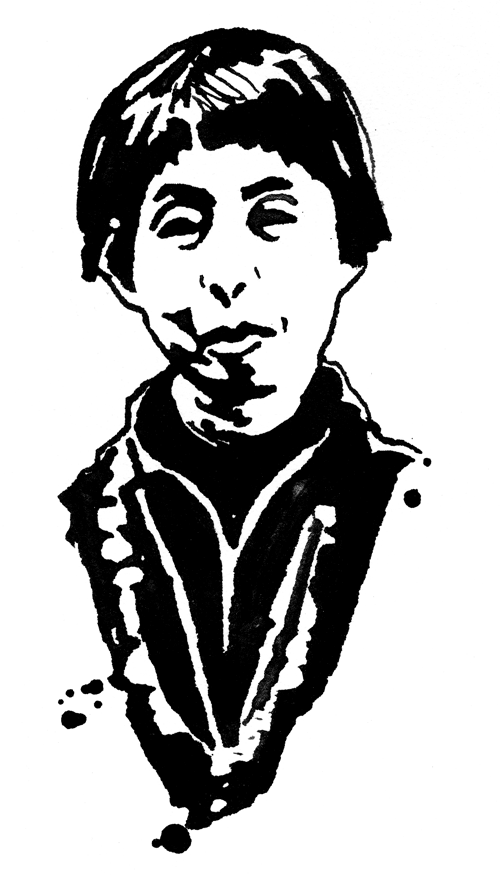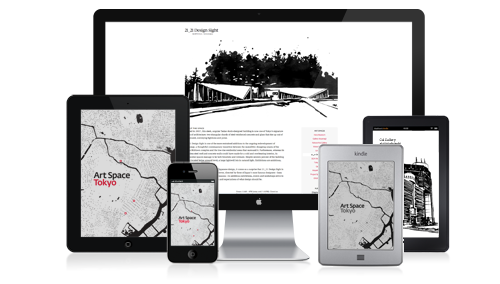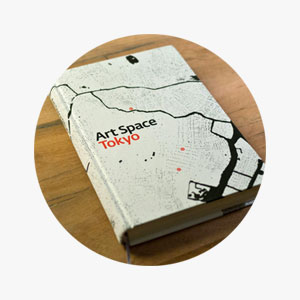A Triangular Temple to Modernism
An interview with Etsuko Watari
Watari Museum of Contemporary Art, Gaienmae

ETSUKO WATARI, curator
Born in Tokyo in 1956. Graduated from the History of Art Department, Faculty of Letters, Waseda University. Established the Watari Museum of Contemporary Art in 1990. She has organized and curated exhibitions of works by Carlo Scarpa, Shinzo & Roso Fukuhara and a group show of Hungarian Constructivism. Published works include The Laboratory of Rodchenko and Museum Goods.
What led you to found this museum?
EWMy mother had a collection of contemporary art that she started around 1960. We wanted to build a museum so that we could show it to the public. Nevertheless, we also wanted to explore many other potential exhibition ideas. Being right in the middle of Tokyo, our space isn’t that large, so we can’t hold a permanent show and special exhibition at the same time. As a result, we hold a single show under a single theme each time.
Also, there were hardly any interesting museums in Japan around that time. We usually had to go abroad to see the art we wanted to see. We imagined how nice it would be to have our kind of art near us, no matter how little, so we simply said, “Let’s do it,” and got started. But running a museum turned out to be much more difficult than we had imagined!
In what way?
EWThe financial and advertising aspects of exhibition planning are difficult. In Japan, newspaper companies usually take care of advertising, but it produces very mixed results. Many, many people will go see an exhibition even if it’s not that interesting; and yet on the other hand, even if it’s a great exhibition, if it’s not advertised, many people won’t go. It’s normal to have a large budget for advertising, but we choose not to spend money that way. People will come to our exhibitions and tell their friends that they liked it. We don’t get huge numbers of visitors, but that’s all right because we’re a small museum.
How did you come to know the architect Mario Botta, and in what way did you work with him to develop the design of this building?
EWWe became interested in his work through books and magazines, and contacted him in 1985. We told him that we were going to be exhibiting contemporary art for the next couple of decades and asked him to design a building with that in mind. But if you think about it, nobody knows what forms contemporary art will take in the coming decades. It’s a big challenge to develop a space for something that nobody can predict.
In the beginning, we didn’t have a very detailed plan of what we wanted, so we developed our ideas in response to his questions. It was like talking to a psychiatrist — very revealing. Rather than discuss things like form and function, our talks were much more spiritual, about issues such as how we wanted to deal with art, what possibilities we felt there were and which ones we wanted to explore. It also had a positive influence on Mr. Botta, who went on to design the San Francisco Museum of Modern Art in 1994. He said in an interview with The New York Times that he learned a lot about the possibilities, difficulties and appeal of contemporary art by delving into its essence with us.
We ended up spending three years on these discussions before building work began. Construction took around two years, so this building took five years to complete. This is the reason we now hold many exhibitions on architecture. We have some insight into what architects go through in the process of design and construction.
What were the factors that defined the building’s distinctive triangular shape?
EWThe basis of the building’s shape is a result of Tokyo’s urban planning for the 1964 Olympics. The street outside this museum used to be really narrow, but it was widened so that it could function as the main road to the nearby Olympic National Stadium. As a result, our land was expanded to make space for construction, and our plot became triangular. We built upon that shape, thinking that a triangle would be distinctive. Mr. Botta said he’d never worked on a triangular building before.
What is the character of your mother’s collection?
EWThe collection is composed of art from all over the world: the United States, Europe, South America and, of course, Japan. We started collecting at the end of the 1960s. Being my mother’s private collection, it was built up mostly out of her own personal interests. Looking at it objectively though, the collection has a strong leaning toward Modernism. It’s not fancy, it’s not decorative and it’s not pretty: it includes works by Fluxus and Joseph Beuys that aren’t beautiful at all. Being based on both my mother’s ideas and the ideas of Modernist conceptual artists, this collection is more ideological than your average collection.
What goal is the museum aiming for with its exhibition program?
EWOur basic policy is to focus on Modernism. We introduce artists whose works and ideas are necessary for us to live in this age. We show both young, up-and-coming artists as well as older ones. With a new take on older work, you can turn it into something that’s needed today. For example, in 2007 we held an exhibition of the architect Bruno Taut,1 whose work was made over one hundred years ago but is still modern. The Watari-um is not a museum that displays artifacts for the sake of preserving history. Our mission is to exhibit works for creators living in Tokyo and to seek what is necessary for mankind.
How do you get to know artists? Do you go to events like art fairs or biennales?
EWWe hardly go to art fairs. Their purpose is to sell works, so unless you are there to buy, it’s not a very stimulating environment. We go to biennales and we meet artists there sometimes; most of the time the artists turn out to be friends of friends. We go visit them and see their works a number of times; seeing a lot of different works and having continuous contact with people are the biggest factors in making decisions about who we work with.
How do you and the artists work together to create an exhibition?
EWIf we’re working with a living artist, then it’s critical to have them communicate what they want to achieve in the beginning. After that, we’ll go over the details to see if it can be realized and if for any reason it can’t, we’ll try to offer as many suggestions as possible for alternative approaches. Sometimes we’ll have to be realistic and say no due to budget constraints. It’s important to have the artist submit his or her plans first; then we listen closely to what they want to do.
What exhibition did you find most challenging or rewarding to curate?
EWChallenging? It’s challenging each time! Solo and group exhibitions are very different. Solo exhibitions organized with a living artist have a clear process to them because the artist can make decisions on his or her own, whereas it’s harder to curate the works of a group of artists under a coherent theme; you need a clear concept or else the show loses focus.
I have curated two exhibitions in an ongoing series called Empty Garden,2 and I’m in the middle of preparing for the third one. It’s one of the projects that I’ve dedicated my life to. ‘Emptiness’ is a very Japanese concept; the sheer power of a work created with emptiness is amazing. It’s not about the power of form or size, but of the spirit. It’s a difficult concept to work with, but it’s fascinating and very important to me.
What do you think of the white cube as a space to work in?
EWBoth the positive and negative aspects of the white cube are interesting; it really depends on the work. With the Barry McGee exhibition that we held in 2007,3 we designed the interior to look like outer walls and installed a truck in the main space to make it look like a random backstreet. We often alter things architecturally: the building itself is designed to be very flexible. The top floor has a cavity that allows viewers to look down into the main exhibition space, but we can floor it over when necessary.
To be more radical, we go outdoors. We once used the street to exhibit works. I think it’s very interesting to do the exact opposite of what an ordinary white cube gallery would do. But as I said, it depends on the work: the purpose of the work decides what curators will do with the white cube. However, I don’t think that the white cube is the only option: some works are better exhibited around town.
In what way do you engage with public space?
EWWe’re right in the middle of preparing Seed and Grow, a solo exhibition of the French artist Fabrice Hyber, who will exhibit works under the theme of agriculture. We are going to use the sidewalk along the road from Gaienmae Station and transform each bit of land into a vegetable garden, leading all the way up to this museum. Visitors will be able to enjoy Japanese radishes, cucumbers and tomatoes on their walk from the station to the museum. It’s difficult to execute these kinds of exhibitions, but it’s very rewarding and we always aim to do one a year.
The logistics of realizing a work in public space — obtaining permission from various authorities and so on — must be daunting.
EWYes, it takes a lot of effort. We need to get permission not just from Shibuya Ward but also the Tokyo Metropolitan Government. The authorities vary according to the street. Aoyama Dori, for example, is a national road, so it’s under the jurisdiction of the Ministry of Construction. Gaien Nishi Dori, the road in front of this museum, is under the jurisdiction of the metropolitan government. We visit them, explain what we want to do and ask for their support. For example, if we wanted to create a garden, we need signs to ask nearby residents not to park their bicycles on those spots during that period because it could destroy the plants. Building these relations has serious significance because through our work we come into contact with society and the people who live and work in this area. We start from there, work on building relations, and word about the project will spread around town. Some people will like what we are doing and some won’t, but that’s the thrill we wouldn’t be able to experience if we stayed inside this building all the time.
What do you think of more conventional public art, which usually takes the form of sculpture?
EWThere are some interesting pieces, of course. What’s important is that the work is needed at that particular location and makes it meaningful. There are some pieces like that, but I don’t like works that look like rich people just dumped them there for the sake of it.
Do you think the government gives enough support to the art world?
EWThe government’s support of the Tokyo art world is quite possibly the worst in the world. Watari-um only receives a little bit of financial support from the government; I think we receive more money from corporations. The government seems to give enough support to classical art, but there is something lacking in the way Japan uses its taxes for the support of contemporary art. The most extreme contrast is in how the French government supports contemporary art at national art museums: the fact that they use taxes for that kind of thing is amazing. Whether people like it or not comes next. The system isn’t one hundred percent good or bad; it’s just art in progress. In Japan, there’s a common consensus that taxes can be allocated only when at least ninety out of one hundred people like the idea.
How has contemporary Japanese art changed in the last fifteen years?
EWAs I said in the beginning, there were almost no interesting art museums in Japan when we started building this one eighteen years ago. I’m not sure that much has changed in the way public museums operate. There’s a big gap between art movements and museum programs. Even the newly built National Art Center in Roppongi feels like it’s based on old ways of thinking.
It’s still very hard for young people to make it as artists. Living expenses in Tokyo might already be too high for them. Meanwhile, architects and designers are in a good position. Their work may not be art in the purest sense, but commercial art is respected in Japan; their work takes them to different countries and they enjoy a high social standing. So therein lies the problem: are artists respected in Japan? The Japanese only seem to pay respect to people who can earn money, and that’s a shame.
Looking back at the time when the bubble burst, certainly in financial terms the art world fell into a very severe state of affairs. But at the same time, I think it was good that artists became energized with the realization that money doesn’t grow on trees. That odd sense of greed will pull them in the wrong direction and they stop creating genuine art.
Art is at its strongest when created in the face of extreme adversity; it’s when things are lukewarm that the art world is at its worst. At the moment it’s hard to tell whether artists have money or not and how their financial situation may be affecting the way they make their work. In a sense, the beginning of the 1990s was a good time for art: people began to ask themselves where Japan is headed.

